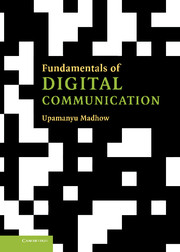Book contents
- Frontmatter
- Contents
- Preface
- Acknowledgements
- 1 Introduction
- 2 Modulation
- 3 Demodulation
- 4 Synchronization and noncoherent communication
- 5 Channel equalization
- 6 Information-theoretic limits and their computation
- 7 Channel coding
- 8 Wireless communication
- Appendix A Probability, random variables, and random processes
- Appendix B The Chernoff bound
- Appendix C Jensen's inequality
- References
- Index
8 - Wireless communication
Published online by Cambridge University Press: 05 June 2012
- Frontmatter
- Contents
- Preface
- Acknowledgements
- 1 Introduction
- 2 Modulation
- 3 Demodulation
- 4 Synchronization and noncoherent communication
- 5 Channel equalization
- 6 Information-theoretic limits and their computation
- 7 Channel coding
- 8 Wireless communication
- Appendix A Probability, random variables, and random processes
- Appendix B The Chernoff bound
- Appendix C Jensen's inequality
- References
- Index
Summary
Freedom from wires is an attractive, and often indispensable, feature for many communication applications. Examples of wireless communication include radio and television broadcast, point-to-point microwave links, cellular communications, and wireless local area networks (WLANs). Increasing integration of transceiver functionality using DSP-centric design has driven down implementation costs, and has led to explosive growth in consumer and enterprise applications of wireless, especially cellular telephony and WLANs.
While the focus of this chapter is on wireless link design, we comment briefly on some system design issues in this introductory section. In terms of system design, a key difference between wireless and wireline communication is that wireless is a broadcast medium. That is, users “close enough” to each other can “hear,” and potentially interfere with, each other. Thus, appropriate resource sharing mechanisms must be put in place if multiple users are to co-exist in a particular frequency band. The wireless channel can be shared among multiple users using several different approaches. One possibility is to eliminate potential interference by assigning different frequency channels to different users; this is termed frequency division multiple access (FDMA). Similarly, we can assign different time slots to different users; this is termed time division multiple access (TDMA). If we use orthogonal multiple access such as FDMA or TDMA, then we can focus on single-user wireless link design. However, there are also nonorthogonal forms of multiple access, in which different users can signal at the same time over the same frequency band.
Information
- Type
- Chapter
- Information
- Fundamentals of Digital Communication , pp. 379 - 473Publisher: Cambridge University PressPrint publication year: 2008
Accessibility standard: Unknown
Why this information is here
This section outlines the accessibility features of this content - including support for screen readers, full keyboard navigation and high-contrast display options. This may not be relevant for you.Accessibility Information
- 3
- Cited by
